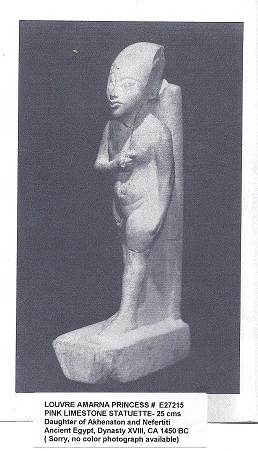What if?
Some misinformed egyptologists have claimed that some of the Mansoor artifacts are copies of wellknown Amarna sculptures. They conveniently forget that the Ancient Egyptians themselves duplicated their own works. For example, in one gallery at the Metropolitan Museum of Arts, there are at least 7, or maybe eight, Sekhmet statues in black granite ( or basalt?), six to seven feet tall and are almost identical copies of each other ! So, what if another one was discovered at a later date, in some private hands, would it be a " suspect " artifact ? And which one of the7 or 8 statues of the Met Sekhmets is the original one and which ones are ancient copies or even modern copies ???
And In Luxor's Avenue of the Rams, which RAM is the authentic one and which ones are fakes ?
So, what if the Mansoor artifacts were discovered before - and they probably were* but never published -, some of the other wellknown artifacts in Oxford, Cairo or Berlin were discovered ? Would these scholars say that the Cairo, Berlin or Oxford artifacts are copies of the Mansoor artifacts and are therefore fakes ? You can't have it both ways!
Let's review what some of the dissident egyptologists have said about the Mansoor artifacts :
Some Egyptologists have claimed that the Mansoor statuettes of the "standing princesses " are copied from those of the Cairo Egyptian Museum (# JE 448731), and the Wm. Rockhill Nelson Gallery of Kansas City (# 47-13), both of which photographs are illustrated in Aldred's book "Akhenaten and Nefertiti" on page 131. Let's compare the above mentioned 2 statuettes one at a time, to the ones in the Mansoor collection and see what we come up with. The princess of the Kansas City Museum has a sidelock, and none of the Mansoor statuettes have one. If the Mansoor statuettes were copied from the K.C. Museum,, the individual who copied them couldn't possibly have missed the sidelock, unless, of course, he was blind (so to speak). Forgers according to Egyptologists, are very good observers and, as much as we hate to say, in some cases they are even better observers than some Egyptologists. For instance : Mr. Dodson in his letter to KMT stated that "The poses and Jewelry are absolutely identical" when he compared the Mansoor two seated princesses to the Ashmolean painting of the two princesses. The poses are very similar, yes; but not identical. In one of the Mansoor's relief, the princess seated in the front has her hand in front of her sister's lips and chin. In the other one, her hand is under her sister's chin and her wrist is in a normal position. In the Ashmolean painting, the princess whose hand is under her sister's chin, has her wrist in an abnormal position. Therefore, we can say that all three poses are similar but not identical. As to the jewelry, and this is where Mr. Dodson erred: one can notice that it is not identical, since the Mansoor princesses are not wearing bracelets. We deduce then that the Mansoor pincesses are not copied from the one of the K.C. Museum, especially that the Mansoor artifacts have been known long before the appearance (in 1947 or 1949) of the statuette of the K.C.Museum. As to the standing princess of the Cairo Museum, it seems to be unfinished. She has no navel, her right nostril is much wider than her left, and therefore needs more recutting to be adjusted, and her eyes are unfinished, although one might say that she has sfumato eyes. If this princess is really unfinished, then the ones in the Mansoor collection couldn't have been copied from it, since they are all finished, and since it is very unlikely that a forger would copy an unfinished statue and create the physical details on his own, This plus the fact that the Cairo statuette has her right leg forward, whereas the Mansoor's have their left forward. If, on the other hand, the Cairo statuette is finished in its present condition, she would have sfumato eyes, and if the Mansoor's were copied from it, they would have sfumato eyes, would not have a navel and would have deformed nostrils.
The conclusion is that the Mansoor princesses are as original and as authentic as those of the Cairo and K.C.Museums, except that they turned out to be more beautiful. As Mr. Forbes stated in his KMT article, he ".... found the individual pieces.... to be HIGHLY ATTRACTIVE examples...." It is indeed a great sin that a small group of dissidents, has stigmatized the Mansoor Collection and prevented its examination by some more astute observers. Any diligent student of egyptology, would have quickly come to the conclusions we have just demonstrated. Indeed, in the near future, we will be able to show that the Mansoor artifacts were " produced " even before some of the better known Amarna artifacts. The above, plus the massive amount of scientific evidence obtained, so far, regarding the Mansoor Collection, makes this collection unquestionably ancient.
Oscar Wilde once said : "The one duty we owe to history is to rewrite it ". Will the new generation of Egyptologists comply ? YES, in the very near future .. For believers, no amount of proof is necessary. For non believers, no amount of proof is sufficient.
* Check http://www.mansooramarnacollection.com/docs/gabra.htm which establishes the approximate date of the existence of the Mansoor artifacts. |



